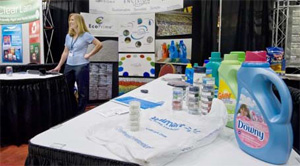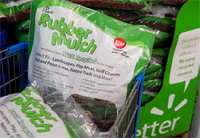Packaging Reduction
Around the globe we are working with our suppliers to develop sustainable solutions to product packaging. Several markets, including the U.S., the Americas, Europe and China, are working to reduce packaging waste by 5 percent by 2013 using a 2008 baseline. In order to move toward this goal, we developed an online packaging scorecard designed to gather information on our suppliers' product packaging in order to establish a baseline and help our buyers make more informed purchasing decisions.
On February 1, 2008, the online packaging scorecard was made available to all of our U.S. buyers, and now buyers may show preference to those suppliers who have demonstrated a commitment to producing more sustainable packaging. Suppliers can use the scorecard to measure how their product packaging helps us achieve, meet or exceed our goals of being supplied 100 percent by renewable energy, creating zero waste and selling environmentally preferable products.
In early 2009, we began rolling out the packaging scorecard to select international markets. Canada will be the first country to integrate the scorecard into its business, and the rollout is expected to be completed by the fall of 2009. The scorecard will be translated into several languages, but will contain the same information and questions as the original scorecard launched in the U.S. Already our suppliers around the world are reducing their packaging and creating more sustainable alternatives.

Currently, we are working with our Packaging SVN to measure our progress toward reducing packaging in our supply chain by 5 percent by 2013 based on a 2008 baseline. There are many factors associated with making packaging more sustainable, including greenhouse gas reductions during manufacture of the package, substrate material choices and chemical composition. We have spent the last several months gathering the information we need about our products to be able to look at these factors through a "cradle-to-gate" approach. In doing this, we will be able to more accurately measure the environmental impact packaging reduction has on our entire packaging supply chain. We have collected information on approximately 300,000 of the items carried in Walmart stores and 90 percent of the items that we collect information on at Sam's Club. As we move forward, we will continue to work with our Packaging SVN members to evaluate the type of information collected and determine how to best measure the progress being made by our suppliers. Click here to learn more about our efforts to reduce packaging.
Americas
United States
Each year, our U.S. Packaging Network hosts a Sustainable Packaging Expo in Bentonville, Arkansas, to connect product suppliers with packaging suppliers who can suggest sustainable packaging options. In 2008, the Expo featured more than 180 sustainable packaging booths and was attended by more than 1,500 product suppliers and 500 internal associates. The Expo also provides attendees with the opportunity to attend several educational sessions featuring speakers from Wal-Mart's U.S. Packaging Network and non-governmental organizations.
In addition to working with our suppliers on the scorecard and the Sustainable Packaging Expo, we have been actively working with our private-label suppliers to increase the sustainability of their packaging. For example, we've made sustainable packaging changes to the apple juice sold under the private Member's Mark label at Sam's Club. Approximately half of the packaging is manufactured using 35 percent renewable energy generated by hydroelectric plants that use moving water to generate electricity. Additionally, 50 percent of the packaging is manufactured from 100 percent recycled corrugated cardboard.

In 2007, we missed meeting our goal to eliminate PVC from our private-brand packaging. We made progress toward this goal by converting PVC clamshells to PET and either completely removing PVC windows in packaging or replacing the PVC windows with PET. While we continue to look for alternatives to PVC, we have been unable to find suitable replacements for PVC used in over-the-counter, tamper-evident bands, metal can sealants and meat wrapping, among others. Until we identify another material of equal performance, we will not eliminate PVC from certain items to ensure the safety of our customers.
Brazil
The makers of Sustax, a drink mix made under our private label in Brazil, were able to reduce packaging without sacrificing the volume of product sold to customers. They did it by making Sustax cans approximately 16 percent smaller, leading to a 24 percent reduction in the label size and a 12 percent reduction in the amount of corrugated cardboard needed to package the cans. These changes have led to an annual savings of 2,800 pounds of steel, 330 pounds of paper and 770 pounds of cardboard.
Europe
United Kingdom
In the U.K., our ASDA stores have reduced the weight of their food packaging by 25 percent compared to a 2005 baseline. More than 2,500 different products on ASDA shelves have been right-sized, leading to a reduction of 40,000 tons of packaging, which is equal to the weight of 5,700 London red buses. Additionally, the packaging on more than 6,000 products provides customers with recycling information.
Asia
Japan
In Japan, our Seiyu stores are actively working to reduce packaging waste. Their produce department has been working with suppliers to develop reusable plastic containers to transport produce in order to make their supply chain more sustainable. They are also reducing the number of trays used in the meat department. So far, by moving from four different colored trays used to store and display different kinds of meats to one white tray for everything, they have saved more than JPY 100 million ($965,000 USD).
China
Following in the footsteps of the U.S. Packaging Network, Wal-Mart China hosted its first Sustainable Packaging Expo in 2008. The Expo helped connect product suppliers in China to suppliers who have sustainable packaging options.
Reusing Materials
We are working with our suppliers to integrate recycled materials into new products. We are showing our customers how these recycled materials can have a positive effect on the environment, while helping them save money and live better.
Americas
United States
Many people wonder where plastic and other materials go once they have been recycled. In the U.S., we are developing a closed-loop recycling program that helps our suppliers get materials recycled from Walmart stores. With the recycled materials, suppliers can make new products that return to Walmart's shelves.
For example, each year, our Tire and Lube Express Centers (TLEs) send millions of tires to recyclers for processing. In 2008, we were able to recycle 16 million tires, and 2.5 million of those tires went into the production of a new product on our shelves, Majestic™ Rubber Mulch. By selling this rubber mulch, we prevent those tires from going to landfills and reduce the number of trees that are cut down to make traditional mulch. Additionally, it is non-toxic and latex-free. This closed-loop system saves money for us, our suppliers and our customers.




